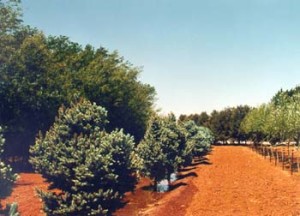
Photo by Holly Hunter
A tree standing alone can provide a definite aesthetic appreciation to rural living, but trees that are planted consistently and used as management tools affect many aspects of the farm or ranch.
Windbreaks are trees and shrubs of different varieties and sizes used to reduce and redirect the wind. They are planted strategically and systematically adjacent to fields, homesteads, feedlots and other areas for protection from the wind.
The trees used to create windbreaks can reduce soil erosion by wind, increase land value, enhance aesthetics and contribute to controlling runoff. They also are a great source of protection for animals, crops and natural resources. Don Lowe, a farmer near Maple, TX, in Bailey County has an established homestead windbreak that protects and provides for his home and farming operation.
“We use our trees to get as much protection as we can,” Lowe comments. A member of Plains Cotton Cooperative Association (PCCA) since 1954, Lowe began establishing the living boundaries that surround his home and land in 1973.
“Every year we continue to add to our windbreaks,” he says. As the windbreaks grow, so does the surrounding natural habitat for birds and animals.
“We have so many types of birds we enjoy watching and listening to,” Lowe expresses. “Windbreaks are a good habitat for wildlife.” Lowe peers at the bird’s nests that thrive in his trees and knows that they have attracted and sustained various wildlife populations.
Lowe attributes proper management to maintaining the overall structure of the windbreak. He also notes there are many factors to take into consideration when planting a windbreak.
“You need to adjust your trees to your water supply,” urges Lowe. “You also have to position your trees correctly because they can’t be too close or too far apart.” The proper planting of windbreaks creates a management tool that affects every aspect of the farm or ranch. Before planting a windbreak, it is essential to determine the area or structure in need of protection. Another effective moisture supply for a windbreak is a winter snow.
“The trees will catch the snow and keep it from blowing around the farm area, and good moisture is left for the summer where the snow is captured,” Lowe says. Homestead windbreaks that prevent snow build-up can be referred to as living snowfences. These living fences prevent snow build-up against the house and along the entryway or driveway leading to the home. In northern rangelands, windbreaks can be designed to trap snow and provide water for livestock.
Homeowners not only receive the benefit of protection from wind and soil erosion, but they also are able to conserve energy with multiple-row windbreaks. As the windbreaks protect the homesite, they reduce energy consumption by shading the home so the air-conditioning and heating units are used more efficiently.
“We enjoy the shade on a real hot summer day, and the cooling effect helps to prevent the refrigeration unit from coming on as often,” Lowe says. “In the winter, the trees help to break the gusts of cold wind.” The reduced wind speed also can help to reduce wind chill effects on humans making outside work in winter less stressful, more efficient and safer. Trees also can act as a sound barrier to traffic noise from a highway or farm road.
“Vehicles tend to make a more intense noise after a rain,” Lowe claims. “The trees help to break the noise level.”
Windbreaks also can change the environment in a field and assist in protecting crops and soil from wind erosion. Field windbreaks may require that some land is removed from crop production, but the results can include a net increase in total crop yield and crop quality. A field windbreak can provide the opportunity for crop diversity offering the potential to increase the natural control of pest outbreaks and contribute to the ecological stability and resilience of the farm ecosystem.
The windbreak also provides homes with a diverse habitat including microbes, insects, plants and wildlife. Thorough planning and management of field windbreaks can improve economic return by enhancing insect predators and reducing the need for pesticides.
Quality seedlings to plant a successful windbreak are available at the Texas Forest Service’s West Texas Nursery, located northeast of Lubbock. The nursery’s primary objective is to produce and sell a variety of quality seedlings at a price landowners can afford allowing them to plant large quantities of trees for windbreaks. Nursery staff members are available to personally assist and educate High Plains producers in developing a plan for a successful windbreak.
The nursery has the essential items needed to plant a windbreak including a tree planter which can put 400 to 500 seedlings in the ground per hour, and a fabric layer which rolls out a UV synthetic fabric over the soil surface. The purpose of the fabric is to conserve moisture and help reduce soil erosion. The nursery reported record tree sales this year and anticipates a growing interest in the service throughout next year.
For more information or assistance in planting a windbreak, contact the Texas Forest Service West Texas Nursery at (806) 746-5801.


